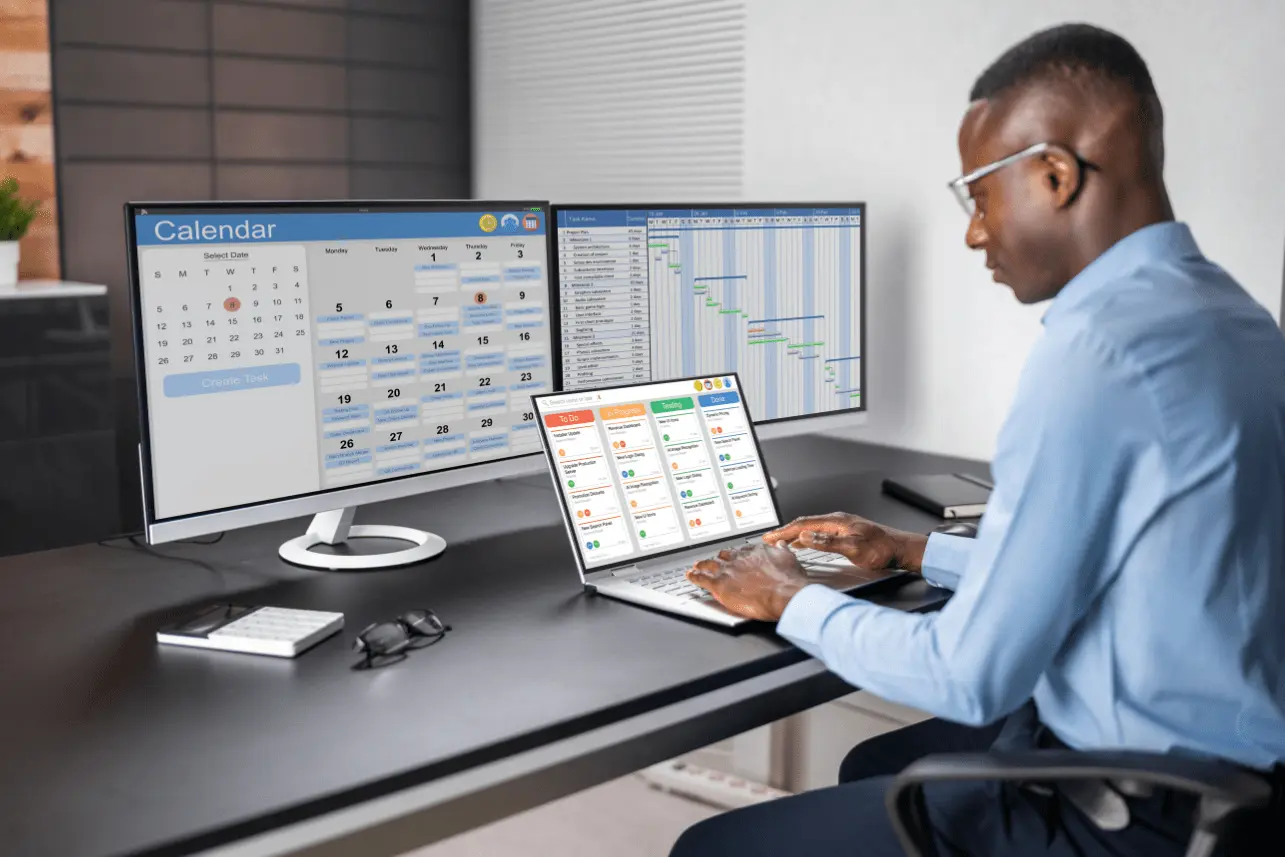How End-to-End Project Tracking Empowers Project Managers to Deliver on Time and Within Budget
In today's fast-paced business environment, the pressure on project managers to deliver projects on time and within
budget has never been greater. The complexity of modern projects, often involving multiple stakeholders, resources,
and tight deadlines, makes it essential for project managers to have a clear and comprehensive view of every phase of the project lifecycle.
This is where end-to-end project tracking comes into play. By leveraging end-to-end project tracking, project managers can gain complete
visibility over their projects, improve team collaboration, and ensure successful project delivery.
The introduction of The Best Project Management Tools for Teams in 2025 has made this level of comprehensive oversight more
attainable than ever before. These tools provide the features needed to plan, track, and execute projects efficiently, empowering
project managers to deliver results that meet or exceed expectations. But what exactly is end-to-end project tracking, and how can
it help project managers deliver on time and within budget?
End-to-end project tracking refers to the continuous monitoring and management of a project from its initiation to its completion. This involves tracking all aspects of the project, including planning, task assignment, resource allocation, deadlines, progress, risks, and budget. End-to-end project tracking ensures that no phase of the project is overlooked and that all components are moving forward as planned.
In the context of The Best Project Management Tools for Teams in 2025, this kind of tracking is made easier with integrated features such as real-time dashboards, automated reporting, collaborative task management, and resource allocation tools. With these tools, project managers can track every aspect of the project in one centralized location, allowing for seamless communication and better decision-making.

Without end-to-end project tracking, managing a project can become chaotic. It is easy for deadlines to be missed, budgets to be exceeded, and project goals to be forgotten. A lack of comprehensive tracking creates gaps in visibility and accountability, making it difficult for project managers to anticipate issues or adjust strategies in time.
For example, if a project manager is only tracking one aspect of the project, such as the completion of tasks, they may miss potential issues in other areas, like budget overruns or resource shortages. This fragmented approach often leads to delays, increased costs, and scope creep. End-to-end project tracking eliminates these risks by providing a holistic view of the project.
How End-to-End Project Tracking Empowers Project Managers
Improved Planning and SchedulingOne of the most significant advantages of end-to-end project tracking is its ability to improve project planning and scheduling. By tracking every phase of the project, project managers can allocate resources more effectively, estimate timelines more accurately, and anticipate potential delays. Integrated features of The Best Project Management Tools for Teams in 2025 allow project managers to create detailed project timelines, set milestones, and break down large projects into manageable tasks. These features help ensure that all elements of the project are aligned and that timelines are realistic and achievable.
Real-Time Monitoring and Progress TrackingReal-time monitoring is another critical feature of end-to-end project tracking. In the past, project managers had to rely on periodic status reports, which could result in outdated or incomplete information. However, with the best project management tools, project managers can track project progress in real-time, ensuring they are always aware of potential delays or issues that may arise.
By tracking each task and milestone in real-time, project managers can identify bottlenecks, assess the impact of delays, and quickly take corrective action. Real-time tracking enables better communication between teams and stakeholders, ensuring everyone is on the same page throughout the project lifecycle.

One of the most significant concerns for any project manager is staying within budget. With end-to-end project tracking, managing budgets becomes easier, as it provides a clear view of the financial status at every stage of the project. Through integrated cost tracking features in The Best Project Management Tools for Teams in 2025, project managers can monitor expenses, compare actual costs to projected costs, and make adjustments as necessary to avoid overspending.
When budgets are tracked in real-time, project managers can identify cost overruns early on and take corrective measures to stay on track. This might involve reallocating resources, adjusting timelines, or even renegotiating with suppliers and vendors.
Enhanced Risk ManagementEvery project comes with its set of risks, whether related to resources, timelines, or external factors. End-to-end project tracking provides the visibility needed to identify and manage risks effectively. By tracking all project elements—from resource allocation to task completion—project managers can spot early warning signs of potential risks. These might include delays in critical tasks, resource shortages, or external issues that may impact the project’s timeline.

With The Best Project Management Tools for Teams in 2025, project managers can use built-in risk management tools that allow them to assess and mitigate risks throughout the project lifecycle. These tools often include features like risk assessment matrices, risk registers, and predictive analytics to help project managers stay ahead of potential issues.
Better Collaboration and CommunicationEnd-to-end project tracking also enhances collaboration and communication across teams. By having a single platform where all project data is accessible, team members can stay updated on task progress, dependencies, and changes in real-time. The Best Project Management Tools for Teams in 2025 often include features like shared task lists, discussion boards, and file-sharing capabilities, which make it easier for teams to collaborate efficiently.
Clear and open communication channels are crucial for project success. With end-to-end project tracking, project managers can ensure that all team members are aligned, reducing the risk of miscommunication and misunderstandings.
Informed Decision-MakingWith comprehensive data from every stage of the project, end-to-end project tracking enables project managers to make more informed decisions. Whether it’s reallocating resources, adjusting timelines, or addressing budget issues, having access to real-time data allows for quicker and more accurate decision-making.
The Best Project Management Tools for Teams in 2025 often feature dashboards that provide a comprehensive view of all project data in one place. These dashboards allow project managers to track key performance indicators (KPIs) and metrics, which are crucial for evaluating the project’s health and performance.
Tracking Dependencies and MilestonesProjects often involve multiple tasks that depend on each other. If one task is delayed, it can have a ripple effect on the entire project. End-to-end project tracking allows project managers to track these dependencies and adjust the schedule as needed to minimize delays. By understanding how tasks are interrelated, project managers can prioritize critical tasks, allocate resources more effectively, and prevent bottlenecks from derailing the entire project.
In The Best Project Management Tools for Teams in 2025, tools like Gantt charts and Kanban boards make it easy to visualize task dependencies, milestones, and timelines. These tools help project managers see how each task contributes to the overall project and make adjustments when necessary.
Post-Project EvaluationFinally, end-to-end project tracking provides valuable insights for post-project evaluation. Once the project is completed, project managers can analyse the data collected during the project lifecycle to assess what went well and what could be improved. This data can help refine future project management processes, leading to better outcomes in subsequent projects.
Why End-to-End Project Tracking is Crucial for 2025
As we look toward 2025, the role of technology in project management will continue to evolve. With an increasing reliance on remote teams, global collaboration, and the need for faster project delivery, end-to-end project tracking will become even more essential. Project managers will need tools that can handle complex, multi-faceted projects while ensuring that they remain on schedule and within budget.
The Best Project Management Tools for Teams in 2025 will be equipped with artificial intelligence, machine learning, and predictive analytics to provide even greater levels of insight and foresight. These tools will offer deeper integration with other business systems, making it easier for project managers to access the data they need to make quick, informed decisions.
Conclusion
In conclusion, end-to-end project tracking is a powerful tool for project managers who want to ensure their projects are delivered on time and within budget. By providing a comprehensive view of every phase of the project lifecycle, end-to-end project tracking enables project managers to plan better, monitor progress in real-time, manage budgets, mitigate risks, and improve collaboration. As we move into 2025, The Best Project Management Tools for Teams in 2025 will continue to empower project managers to meet these challenges head-on and deliver successful projects that exceed stakeholder expectations.
Copyright © 2025 Zodobay.com All Rights Reserved
